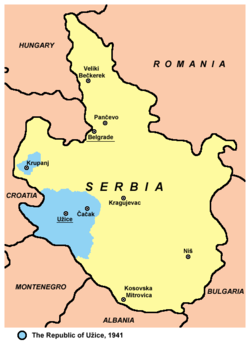Republic of Užice
Short-lived liberated territory in World War II From Wikipedia, the free encyclopedia
The Republic of Užice (Serbo-Croatian: Užička republika / Ужичка република) was a short-lived liberated Yugoslav territory and the first liberated territory in World War II Europe, organized as a military mini-state that existed in the autumn of 1941 in occupied Yugoslavia, more specifically the western part of the Territory of the Military Commander in Serbia.[a] The Republic was established by the Partisan resistance movement and its administrative center was in the town of Užice.
This article needs additional citations for verification. (January 2012) |
Republic of Užice Užička republika Ужичка република | |||||||||
|---|---|---|---|---|---|---|---|---|---|
| 1941 | |||||||||
|
Flag | |||||||||
| Anthem: None official[a] | |||||||||
 | |||||||||
| Status | Partisan Liberated Territory | ||||||||
| Capital | Užice | ||||||||
| Common languages | Serbo-Croatian (de facto Užičan dialect) | ||||||||
| Chairman[b] | |||||||||
| General Secretary[c] | |||||||||
| Legislature | Main National Liberation Committee for Serbia | ||||||||
| Historical era | World War II | ||||||||
• Partisan arrival in Užice | 28 July 1941 | ||||||||
• Battle of Drežnik | 18 August 1941 | ||||||||
• German ultimatum | 10 September 1941 | ||||||||
• Fall of Užice | 24 September 1941 | ||||||||
• Battle of Kadinjača | 29 November 1941 | ||||||||
| 1 December 1941 | |||||||||
| |||||||||
| Today part of | Serbia | ||||||||
| |||||||||

Borders
The Republic of Užice comprised a large portion of western part of the occupied territory and had a population of more than 300,000[3] (according to another source, nearly one million[4]). It was located between the Valjevo–Bajina Bašta line in the north, the river Drina on the west, the river Zapadna Morava in the east, and the Raška region to the south.[citation needed]
Different sources provide differing information about the size of the republic: according to some sources, it included 15,000[4] or 20,000[5] square kilometres.
History
The government was made of "people's councils" (odbori), and the partisans opened schools and published a newspaper, Borba (meaning "Fight"). They even managed to run a postal system and around 145 km of railway and operated an ammunition factory from the vaults beneath the bank in Užice.[6]
In November 1941, in the First anti-Partisan offensive, the German troops occupied this territory again, while the majority of Partisan forces escaped towards Bosnia, Sandžak and Montenegro, re-grouping at Foča in Bosnia.[7]
End
The leftist policy then pursued by Josip Broz Tito (known later as the leftist errors) substantially contributed to the defeat of the partisans in the Republic of Užice.[8] Because of the pro-fascist Serbian propaganda which described the partisans as being led by foreigners,[9] the population of Serbia turned against the uprising and against the partisan insurgents. At the beginning of December 1941[10] the partisans moved from Serbia to Bosnia (nominally part of the NDH) and joined their comrades who had already left Montenegro.[11]
In popular culture
The 1974 Yugoslav partisan feature film The Republic of Užice covers the events surrounding the existence of the Republic of Užice.
See also
- Republic of Bihać, a similar, albeit created 1 year later, republic in Bosnia and Herzegovina.
- Former countries in Europe after 1815
Notes
References
Bibliography
Further reading
External links
Wikiwand - on
Seamless Wikipedia browsing. On steroids.

